A tour of Spain is not considered without churches in Spain. These are the special charms of this nation. Spain is known for many things, some of which include Flamenco dancing and paella. Spain is also a nation with a strong Catholic foundation, and a portion of Spain’s holy places are among the best on the earth. Whether or not you strictly follow your religion, your next trip to Spain should include a couple of stops at the country’s most lovely and notable religious structures. When it comes to churches in Spain, we know we have plenty of options to look at. But, there are some best ancient churches in Spain that go beyond spirituality and artistry.
List of Spanish Churches
1. Mezquita of Cordoba

Mezquita of Cordoba
The two religions and cultures i.e. Islam and Christianity have shaped in Córdoba’s Mosque-Cathedral. It is a stunning religious monument of Spain. Later replaced by a Christian Visigoth church, the site was originally home to a Roman temple. When the Moors took Andalusia from the Christians in 711, the Visigoth structure was divided into two halves and used as a place of worship by both Muslims and Christians – a perfect example of unity of different cultures, given the fervour of the times. But it remained only for a short span of period, in 784, on the orders of the Emir Abd al-Rahman, the church was completely destroyed and work on a great mosque began. In 1234, after Cordoba was recaptured by King Ferdinand III and rejoined Christendom, the mosque became used as a church. The cathedral’s construction lasted until the beginning of the 17th century. As the cathedral was constructed although parts of the column hall had been destroyed, the building is still a dazzling and remarkable symbol of fine Moorish architecture. This catholic church in Spain is most notable for its red-and-white colored giant arches resting on 856 columns. These were made of a Roman temple and other buildings that had occupied the Mezquita site previously.
Address: Calle Cardenal Herrero, 1, 14003 Córdoba, Spain.
2. Sagrada Familia
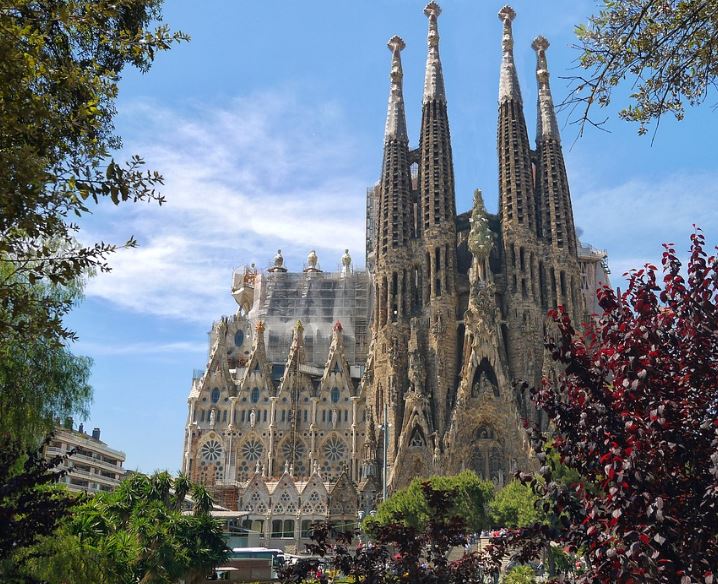
Sagrada Familia
The construction of this stunning church began in 1882 and Gaudí continued to work until his death in 1926. This most beautiful church in Spain is still under construction (currently, only 8 of the 18 towers Gaudí planned to build are finished), but it is already accessible to the public. The basilica should be completed in 2026, a hundred years after the architect’s death, its exterior is magnificent. The basilica has three majestic façades, each depicting a significant event from Christ’s life: Nativity Façade picturing the birth of Jesus, Passion Façade dedicated to Jesus’s suffering during his crucifixion and Glory Façade representing his glory after the resurrection. The interior is also stunning thanks to its high ceilings and tree-like columns. Gaudí made great use of light when designing the cathedral – admire the colorful windows and the play of lights between walls made of white marble. Reserve your tickets beforehand to avoid long lines and note that entry to the towers is not included in the basic ticket. Various guided tours are available for both individuals and groups on the official website.
Address: Eixample, Barcelona, Spain.
Read More: Top 10 Cruise in Spain
3. Avila Cathedral

Avila Cathedral
In the Romanesque style, construction was originally begun but the project was subsequently taken over by the master architect Fruchel, who built one of the first Gothic cathedrals in Spain. This religious site is integrated into the city wall, which formed part of the city’s defensive fortifications. It has two doors: the main door, flanked by two towers –one unfinished– which give it an appearance of a church-fortification, and the door of the Apostles at one side. It is laid out in the shape of a Latin cross. The choir and the cloister were added later in the 16th century. The main chapel has magnificent paintings by Berruguete and Juan de Borgoña and an altarpiece by Vasco de la Zarza. The stained-glass windows date from the 15th century. The ambulatory contains the culminating work of Vasco de la Zarza, the sepulcher of El Tostado, in alabaster.
Address: Plaza de la Catedral, 8 05001 Ávila (Castilla y Leon), Spain
4. Santa Maria la Real de Covadonga
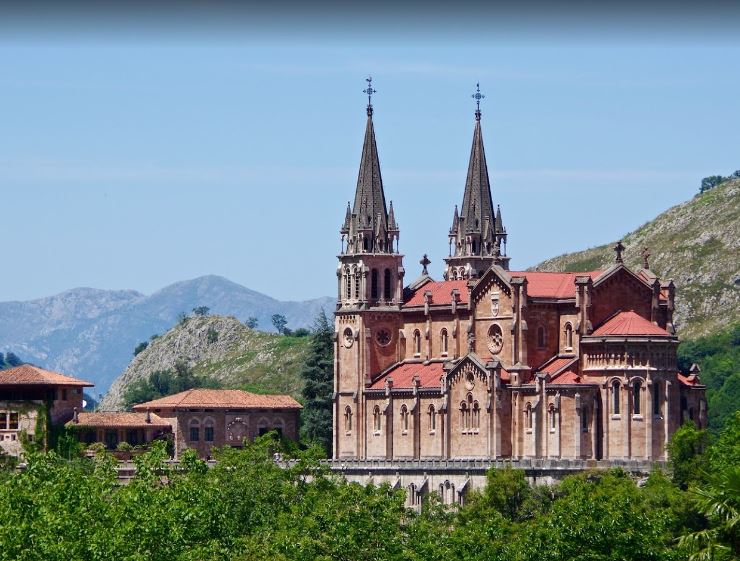
Santa Maria la Real de Covadonga
The neo-Romanesque cathedral was built toward the end of the 19th century and known as one of the ancient churches in Spain. The Basilica of Santa María la Real de Covadonga was designed by Roberto Frassinelli and built between 1877 and 1901 by the architect Federico Aparici y Soriano. It is a Catholic church in neo-Romanesque style, built entirely in pink limestone, which contrasts with the green of the landscape. The image of the Virgin of Covadonga is deeply rooted in the people of this land and constitutes one of the most powerful and convincing signs in Asturias. The shrine in the cave is the most spiritually moving sight here. While the church is an outstanding feature in the landscape, the interior is disappointing.
Address: Address: Covadonga, Cangas de Onís, Spain.
Experience: Best Hiking In Spain
5. Segovia Cathedral
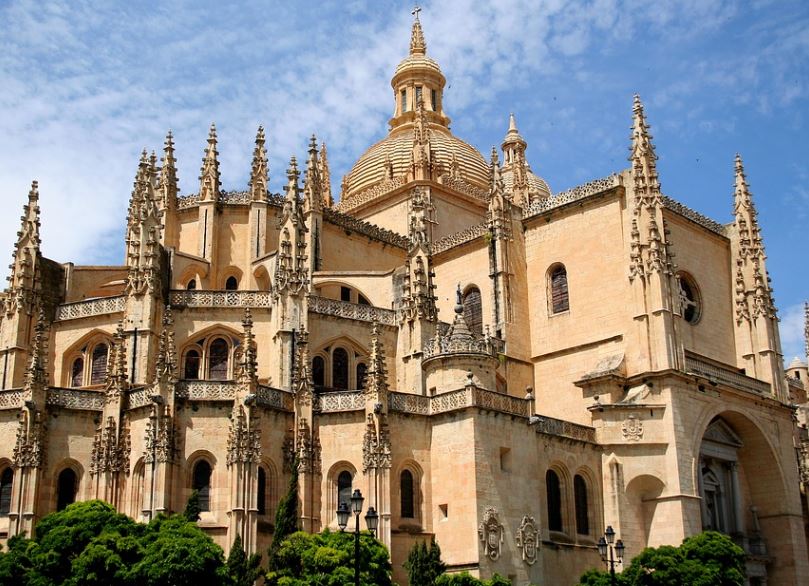
Segovia Cathedral
Segovia Cathedral, known as the Catedral de Segovia in Spanish, is located in the Plaza Mayor of Segovia, Spain. This famous cathedral in Spain is one of the city’s most famous landmarks and is known for being one of the last Gothic cathedrals that was built in Europe. It is often visited by tourists who are staying in Madrid that desire to see other nearby cities. In the early 16th century, the construction of Segovia Cathedral began. The new cathedral was constructed with three large naves and an ambulatory that featured beautiful stained glass windows, as well as a 90m tall tower. Its original spire, built entirely from wood from the Americas, making it the tallest structure in Spain, though it has since been replaced. One of the most popular ways to visit Segovia is as a day trip while staying in Madrid. If you don’t have a car, there are several ways to reach the city from Madrid using public transportation.
Address: Plaza Mayor, s/n, 40001 Segovia, Spain
6. Cathedral of Santa Maria of Palma

Cathedral of Santa Maria of Palma
Commissioned by James I of Aragon in 1229, this imposing cathedral was built on the site of an old Arab mosque. It took nearly 270 years to complete and it was eventually finished in 1601. The cathedral was later re-designed by Antoni Gaudí. It is one of the famous catholic churches in Spain to visit and rightfully so – the architecture is simply breathtaking. One of the cathedral’s main features is its hall-church or basilica floor plan, a German influence which was typical in the Mediterranean Gothic and did not follow the French style of a Latin cross plan. Three naves form a wide rectangular space supported by very tall and slim pillars, and the central nave is one of the highest among the European Gothic cathedrals, with 44 meters (beaten only by Beauvais, 48 meters, and Milan, 45). The temple has a lot of light thanks to its 87 large windows and seven rose windows, which is why it is also known as the ‘Cathedral of Light’. The interior decoration is mainly Baroque and most of it dates back to the 17th and 18th centuries. The altarpieces in its 16 side chapels are from that period and in that style, although the most famous one is that presiding the left apse, the Corpus Christi altarpiece by Jaume Blanquer, representing the Last Supper.
Address: Plaça de la Seu, s/n, 07001 Palma, Illes Balears, Spain.
7. Toledo Cathedral
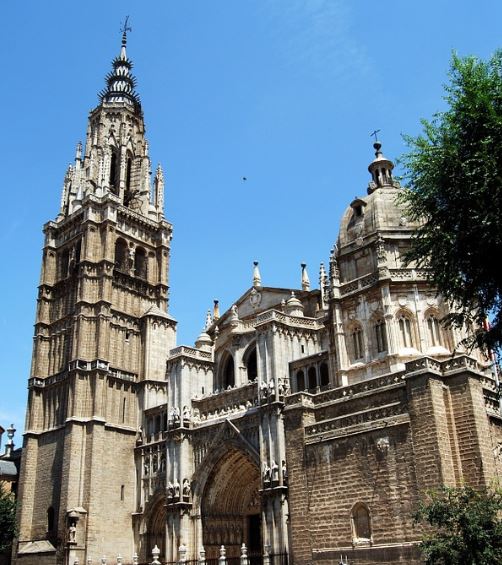
Toledo Cathedral
Toledo Cathedral in Spain is ranked among the greatest Gothic structures in Europe. Including a spectacular baroque high altar and two paintings by El Greco you will see inside the cathedral. Toledo Cathedral stands on the site of the Great Mosque of Toledo and it is said that the mosque itself had replaced a Visigothic church. The long process is reflected in Toledo Cathedral’s variety of styles that built from 1226 to 1493. Many historic events have been hosted in the cathedral over the years, including the proclamation of Joanna the Mad and her husband, Philip the Handsome, as heirs to the throne of Spain. The primarily 13th-century architecture of this most beautiful church in Spain was inspired by the Gothic cathedrals of France such as Chartres, but the squat proportions give it a Spanish feel, as do the wealth and weight of the furnishings and the location of the elaborate choir in the center of the nave.
Address: Calle Cardenal Cisneros, 1, 45002 Toledo, Spain.
Read More: Best Things to Buy in Spain
8. Burgos Cathedral

Burgos Cathedral
The Burgos Cathedral, also known as Cathedral of Saint Mary of Burgos, is a Gothic cathedral located in Burgos, in northern Spain. This beautiful church in Spain is famous for being a masterpiece of Spanish Gothic architecture, and it’s well-known for its vast dimensions and rich and unique history. In 1984, the cathedral was added to the list of World Heritage Sites. Let’s find out more about this building. The construction of the Burgos Cathedral started in 1221, by orders of the king of Spain. It was built on land that had been previously occupied by an older cathedral of earlier medieval Romanesque style. By the year 1238, much of the structure had been completed. After that, the pace of construction slowed down significantly. Between the late 13th century and the early 14th century, a new cloister was built, and the chapels on the aisles were added to the complex. The official consecration of the temple was made in 1260, but work continued; construction ended around 1567.
Address: Plaza de Santa María, Burgos, Spain.
9. Santiago de Compostela Cathedral
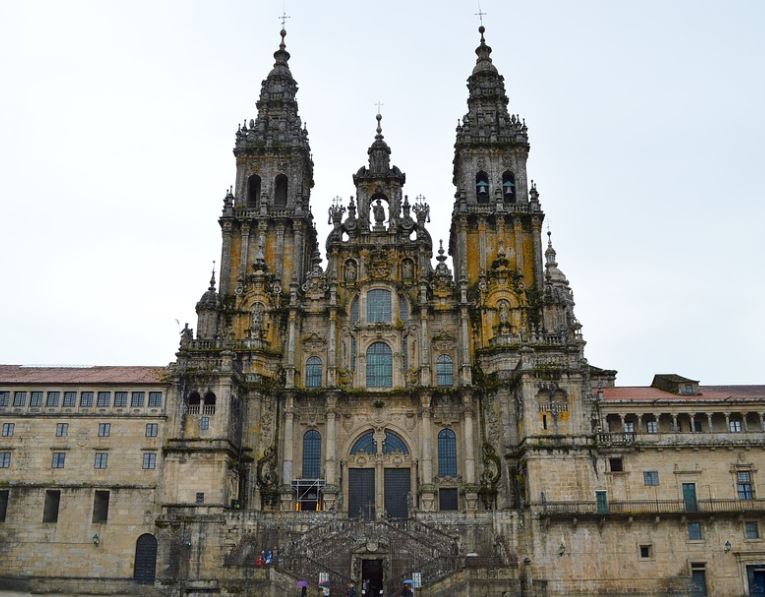
Santiago de Compostela Cathedral
Over the centuries thousands of pilgrims from all over the world have made their way to the Cathedral of Santiago de Compostela, in Galicia, North West of Spain. The pilgrims’ routes are known as the Camino de Santiago, the ways to Santiago. The Camino is a network of different trails spread across Europe, all sharing one goal and destination: the cathedral of Santiago de Compostela. It is here, in the cathedral, in a crypt beneath the Main Altar, where pilgrims can visit the Tomb of the Apostle St James, kept in a silver urn, alongside those of his disciples Saint Athanasius and Saint Theodore. As well as being one of the most important pilgrimage destinations in the world, the cathedral of Santiago de Compostela is a magnificent work of art and religious architecture. While the building preserves its original medieval structure and Romanesque essence, its character and unique beauty have been reinvented over time, with Gothic and Baroque touches shaping today’s masterpiece.
10. Seville Cathedral
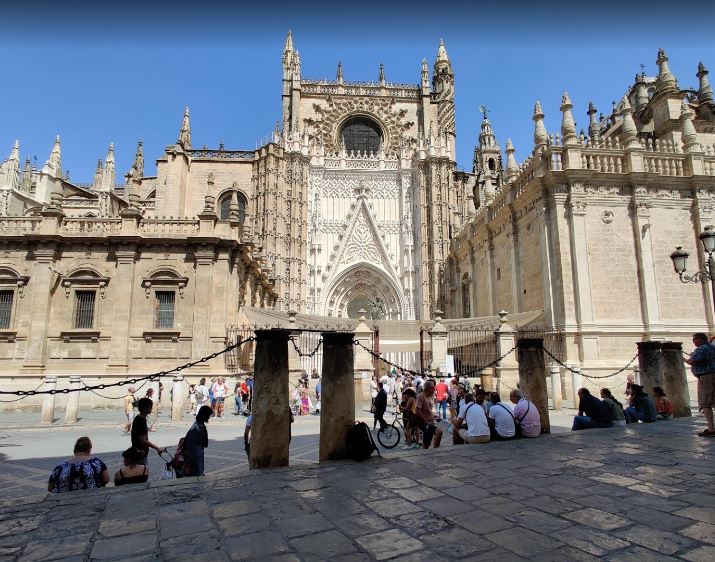
Seville Cathedral
This majestic cathedral in Spain was built in the 16th century, after a hundred years since the construction started, and replaced a former mosque. Its bell tower, Giralda, was originally a minaret. The grand building contains 80 chapels and it is the largest Gothic cathedral in the world. In addition, it features the largest altarpiece in the world. Declared a UNESCO World Heritage Site, it attracts many visitors. Peek inside and note the stained-glass windows and the richly decorated interior. This ancient church in Spain is also the burial place of the famous explorer and navigator Christopher Columbus and Alfonso X of Castile, the 13th century King of Castile, León and Galicia. You can get here by tram, station Archivo de Indias (line 1) or by metro, station Puerta de Jerez, line 1.
Address: Casco Antiguo, Seville, Spain.
11. Temple Expiatori del Sagrat Cor
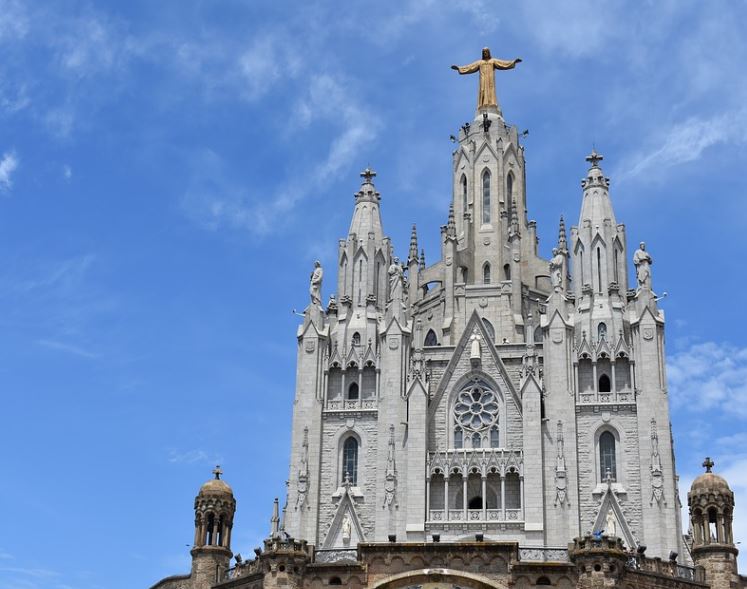
Temple Expiatori del Sagrat Cor
Barcelona is one of the most popular tourist attractions in Spain. This beautiful city is drowning in splendid architecture, captivating history, and fascinating culture. But, one truly iconic sightseeing spot and the stunning church in Spain is Temple Expiatori del Sagrat Cor. Standing almost 1800 feet above sea level on Mount Tibidabo, the temple offers an unforgettable view of Barcelona. Commonly known as “Temple of Tibidabo,” is translated as the “Temple of the Sacred Heart of Jesus”. At first glance temple’s architecture seems strange. However, the story behind its construction clarifies the mystery. During the second half of the 19th century, it was rumored, that a new Protestant temple was about to be built in the city. In order to prevent that from happening, the “Junta de Caballers Catolics” (The Board of Catholic Knights) bought the land and donated it to John Bosco. Idea was to build a church dedicated to The Sacred Heart of Jesus. This was a widely promoted idea at that time, as the church Sacro Cuore di Gesu was built in 1887 in Rome. And later in 1914, the basilica de Sacre-Coeur was built in Paris. The entire exterior surface of the temple is filled with sculptures and beautiful details, that are truly breathtaking and can take hours to study. Overall, the Temple of the Sacred Heart of Jesus is definitely worth visiting the mountain of Tibidabo, while on vacation in Barcelona.
Address: Cumbre del Tibidabo, 08035 Barcelona, Spain.
12. Basilica of Our Lady of the Pillar

Basilica of Our Lady of the Pillar
The large church named Basílica de Santa Maria del Mar in the Catalan Gothic style was probably built as early as in the 10th century. The construction of the current church started in the 14th century and the foundation stone was laid by King Alfonso IV of Aragon. It has an airy and bright interior. The old church in Spain was damaged several times in the past, most recently during the Spanish Civil War when it was set on fire. Fortunately, the fire didn’t reach high enough and the stained glass windows from the 15th century were spared. Guided visits are available to the Basilica, Crypt, and roof terraces. The church also features a neoclassical chapel that is open for worship.
Address: Basílica de Santa Maria del Mar, Barcelona, Spain.
Related Post:
The famous churches in Spain are explained so far. We discussed the churches of Spain, which also includes information about the most beautiful churches in Spain and the churches in Spain. I hope you will love this article as we have tried to provide you as per your concern and kindly share your views in the comment section.
The post 12 Most Ancient Churches in Spain I Famous Churches in Spain appeared first on World Tour & Travel Guide, Get Travel Tips, Information, Discover Travel Destination | Adequate Travel.